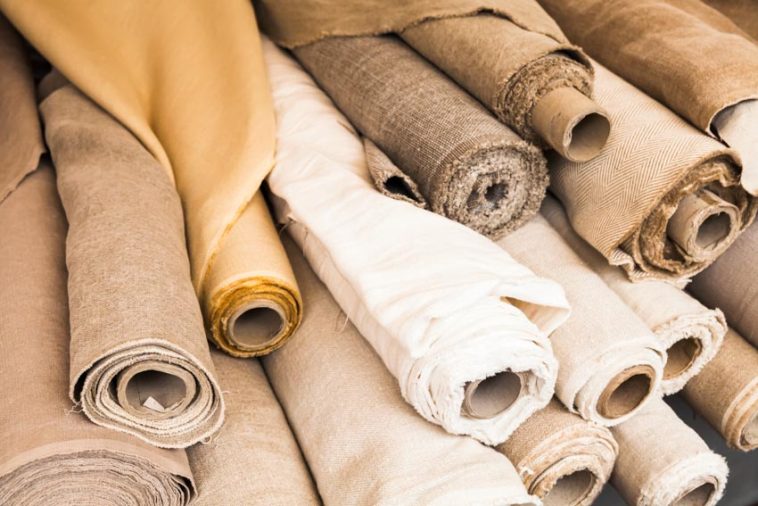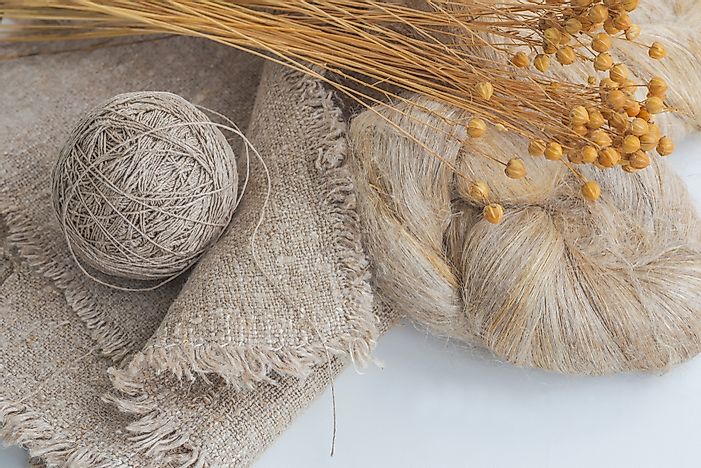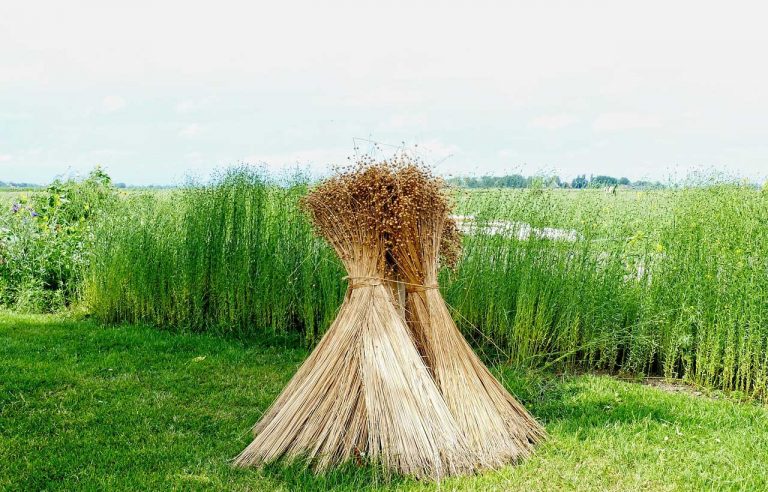Linen is a natural textile made from the fibers of the flax plant. It is one of the world’s strongest natural fibers, far more durable than cotton. Linen is highly breathable and absorbent, making it comfortable to wear in hot weather and is valued for use in garments. Its porous nature and moisture-wicking properties make it a popular summer fabric for clothing or bedding. Linen is a natural conductor of heat, keeping you warm but retaining the heat in its fibers, not your skin. Its natural fibers hold dye colors better than other materials; thus, the fabric is available in almost any imaginable color. Linen is naturally antibacterial and antifungal, it’s hypoallergenic, making it a good alternative for people with allergy sensitivities. It is one of the longest-lasting natural fabrics, outpacing cotton, and can last 30-plus years. This sustainable textile is quickly biodegradable, requires less water than cotton to cultivate, and can grow in challenging environments, making it an earth-friendly choice.
The History of Linen Fabric
Linen is one of the oldest textiles in the world, with a rich and fascinating history:
- Origins: The earliest evidence of linen production dates back to 36,000 years ago, with dyed flax fibers found in a cave in the Southern Caucasus, West Asia (modern day country, Georgia).
- Ancient Civilizations: Linen was used in ancient civilizations including Mesopotamia4 and ancient Egypt. A 5,000-year-old linen dress was discovered in an Egyptian tomb.
- Biblical References: Linen is mentioned several times in the Bible.
- Middle Ages: Linen continued to be valued for garments in the 16th century and beyond.
- Modern History: In the 18th century and beyond, the linen industry was important in the economies of several countries in Europe as well as the American colonies.
- Lithuanian Linen: Lithuania has a rich heritage of linen production, dating back centuries. Linen has been an integral part of Lithuanian culture, used in everything from traditional clothing to household items.
- Industrial Age: The Industrial Revolution brought significant changes to linen production. Mechanization allowed for mass production of linen fabrics, making it more accessible to the general public.
- Modern Times: In the 20th century, linen experienced a renaissance. The development of new processing techniques made linen softer and more versatile, leading to its resurgence in the fashion industry.
- Future of Linen: The future of linen looks promising. Innovations in textile technology are making linen even more versatile and environmentally friendly.
Linen’s durability, breathability, and natural origins have made it a popular fabric throughout history, and it continues to be widely used today.
How is Linen Fabric made?
Linen fabric is made from the fibers of the flax plant. Here’s a more detailed process of how linen fabric is made:
- Harvesting: Flax plants, the source of linen fibers, are harvested.
- Retting: This process involves soaking the flax plants in water to break down the pectin that binds the fibers to the stem. This allows the fibers to be separated from the stem.
- Drying: After retting, the stalks are dried.
- Breaking: The dried stalks are passed through rollers or beaten to break down the hard stem and separate the fibers.
- Scutching: This process involves scraping the fibers to remove the woody portion and separate the individual fibers.
- Hackling: The fibers are combed to remove short fibers and align the long fibers together.
- Spinning: The fibers are then spun into yarn.
- Weaving: Finally, the yarn is woven into linen fabric.
It’s important to note that manufacturing linen is much more time and resource-intensive than making cotton, which has led to a steady reduction in popularity of this fabric. Nevertheless, the unique desirable attributes of linen have prevented the total cessation of global production of this textile.
The Benefits and Uses of Linen
Linen, made from the fibers of the flax plant, is known for its lightweight, strong, and breathable properties. Here are some of the key benefits and uses of linen:
Benefits of Linen:
- Breathability: Linen fabric’s exceptional breathability keeps the wearer cool and cozy by allowing air to pass through it.
- Durability: Given its exceptional strength and durability, linen fabric is ideal for frequently used products like workwear and bedding.
- Softness: Clothing made of linen is a wonderful choice because it is incredibly soft and gentle on the skin.
- Absorbent: Its porous nature and moisture-wicking properties make it a popular summer fabric for clothing or bedding.
- Heat Conduction: Linen is a natural conductor of heat, keeping you warm but retaining the heat in its fibers, not your skin.
- Easy to Dye: Its natural fibers hold dye colors better than other materials; thus, the fabric is available in almost any imaginable color.
- Antibacterial and Hypoallergenic: Linen is naturally antibacterial and antifungal, making it a popular choice for bandages and bed linens for centuries. It’s hypoallergenic, making it a good alternative for people with allergy sensitivities.
- Long-lasting: It is one of the longest-lasting natural fabrics, outpacing cotton, and can last 30-plus years.
- Eco-friendly: This sustainable textile is quickly biodegradable, requires less water than cotton to cultivate, and can grow in challenging environments, making it an earth-friendly choice.
Uses of Linen:
Linen fabric is a natural textile made from plant fibers for clothing, curtains, tablecloths, pillows, rugs, rope, and more. Its natural texture and earthy tones make it a popular choice for curtains, drapes, and upholstery. Linen’s ability to regulate temperature and absorb moisture also makes it perfect for bedding. Its breathable nature keeps you cool in the summer and warm in the winter, ensuring a comfortable night’s sleep.
Types of Linen Fabric
Linen is a versatile fabric with many different types, each with its own unique characteristics and uses. Here are some of the most common types of linen:
- Damask Linen: Damask linen is woven into jacquard weaving, which combines plain and satin weaves.
- Loosely Woven Linen: Loosely woven linens are engineered to absorb a lot of moisture.
- Plain-Woven Linen: Plain-woven Linen is a highly durable and smooth linen fabric plainly woven.
- Sheeting Linen: Sheeting linen is often used for bed sheets due to its wide width.
- Holland Linen: Holland linen is treated to make it opaque and is often used for shades and lampshades.
- Blended Linen Fabric: Blended linen fabric is often mixed with other materials like cotton or polyester to combine the benefits of multiple fabrics.
- Cambric Linen: Cambric linen is lightweight and closely woven, often used for handkerchiefs and lingerie.
- Butcher’s Linen: Butcher’s linen is a heavy, sturdy, plain-woven linen, originally used for butcher’s aprons.
- Bird’s Eye Linen: Bird’s Eye linen is characterized by small geometric patterns that are reminiscent of a bird’s eye.
- Huckaback Linen: Huckaback linen fabric is often produced from a pure linen or blend of cotton and linen.
Linen Care
Taking care of linen fabric involves a few key steps:
- Washing: Linen should be washed in lukewarm or cold water on a gentle cycle. Avoid using bleach on colored items. For smaller or delicate items, consider hand washing. Never twist or scrub the linen when hand washing.
- Drying: Linen dries quickly and can be air-dried or tumble dried on a low-heat setting. If air drying, lay garments flat on a towel or use a drying rack. Avoid using hangers as they can leave marks on your linen garments.
- Ironing: Iron your linen clothes while they are still a bit damp for the best results. Use low to medium heat settings for linen and cotton on your iron. Don’t press it too much – just make the wrinkles disappear. Colored linen (both dark and bright) should be ironed reverse side out.
- Storing: Store linen in a cool, dry place away from direct sunlight.
- Softening: Tumble drying linen clothes on a low heat setting can help soften the fabric and reduce stiffness. If you prefer air drying, hang your linen clothes in a well-ventilated area and gently pull and stretch them while damp to soften the fabric.
Remember, always check the care label on your linen items before proceeding with washing or drying, as different linen products may have specific care requirements.
IGREEN TEX VIETNAM CO LTD
Address: No. 83 , A4 Street, Ward 12, Tan Binh Dist, HCMC
Tax code: 0315844409
Email: info@igreentex.com
WhatsApp/Viber/Zalo: +84938.045.900




